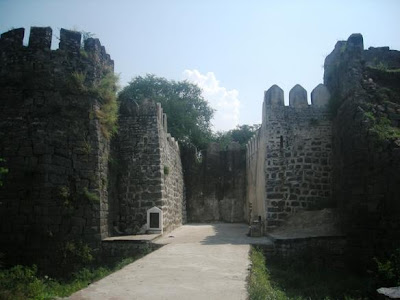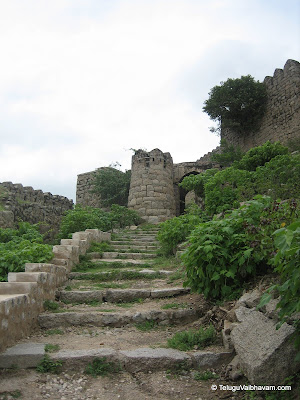
Golkonda (or Golconda), a ruined city of south-central India, is situated west of Hyderabad, capital of ancient Hyderabad state (c. 1364–1512).
It later became one of the five Muslim kingdoms of the Deccan known as the Deccan sultanates, until it was captured by the Mughal Emperor Aurangzeb's forces in 1687. Aurangzeb besieged the fort for nine long months. If it were not for the treachery of a staff who opened a side gate, Golconda would have held out longer.
Three granite walls of megalithic construction surround the Golconda Fort, with the outermost wall having a circumference of about 7 km.The most important builder of Golconda was Ibrahim Quli Qutb Shah Wali, the fourth Qutb king. Ibrahim was following in the spirit of his ancestors, the Qutub Shahi kings, a great family of builders who had ruled the kingdom of Golconda from 1512. Their first capital, the fortress citadel of Golconda, was rebuilt for defense from invading Mughals from the north. They laid out Golconda's splendid monuments, now in ruins, and designed a perfect acoustical system by which a hand clap sounded at the fort's main gates, the grand portico, was heard at the top of the citadel, situated on a 300-foot (91 m)-high granite hill. This is one of the fascinating features of the fort.
Golconda consists of four distinct forts with a 10 km long outer wall with 87 semi circular bastions; some still mounted with cannons, eight gateways, four drawbridges and number of royal apartments & halls, temples, mosques, magazines, stables etc, inside. The lowest of these is the outermost enclosure into which we enter by the "Fateh Darwaza" (Victory gate, so called after Aurangzeb’s triumphant army marched in through this gate) studded with giant iron spikes (to prevent elephants from battering them down) near the south-eastern corner. At Fateh Darwaza can be experienced the fantastic acoustic effects, characteristic of the engineering marvels at Golconda. A hand clap at a certain point below the dome at the entrance reverberates and can be heard clearly at the 'Bala Hisar' pavilion, the highest point almost a kilometer away, this worked as a warning note to the royals in case of an attack.
Bala Hissar Gate is the main entrance to the fort located on the eastern side. It has a pointed arch bordered by rows of scroll work. The spandrels have yalis and decorated roundels. The area above the door has peacocks with ornate tails flanking an ornamental arched niche. The granite block lintel below has sculpted yalis flanking a disc. The design of peacocks and lions is a blend of Hindu - Muslim architecture.
Toli Masjid, situated at Karvan, about 2 km from the Golconda fort, was built in 1671 by Mir Musa Khan Mahaldar, royal architect of Abdullah Qutb Shah. The facade consists of five arches, each with lotus medallions in the spandrels. The central arch is slightly wider and more ornate. The mosque inside is divided into two halls, a transverse outer hall and an inner hall entered through triple arches.
History
In the 16th century, Golconda was the capital and fortress city of the Qutb Shahi kingdom, near Hyderabad. The city was home to one of the most powerful Muslim sultanates in the region and was the center of a flourishing diamond trade. Golconda is located 11 km west of the city of Hyderabad, Andhra Pradesh state, India (location [show location on an interactive map] 17°23′00″N, 78°24′15″E).
According to a legend, the fort derives its name from Golla Konda, which is a Telugu word for Shepherd's Hill. It is believed that a shepherd boy came across an idol on the hill. This led to the construction of a mud fort by the then Kakatiya dynasty ruler of the kingdom around the site.
The city and fortress are built on a granite hill that is 120 meters (400ft) high and is surrounded by massive crenelated ramparts. The beginnings of the fort date to the 1143, when the Hindu Kakatiya dynasty ruled the area. The Kakatiya dynasty were followed by the state of Warangal, which was later conquered by the Islamic Bahmani Sultanat. The fort became the capital of a major province in the Sultanate and after its collapse the capital of the Qutb Shahi kings. The fort finally fell into ruins after a siege and its fall to Mughal emperor Aurangazeb.
After the collapse of the Bahmani Sultanat, Golconda rose to prominence as the seat of the Qutb Shahi dynasty around 1507. Over a period of 62 years the mud fort was expanded by the first three Qutb Shahi kings into a massive fort of granite, extending around 5 km in circumference. It remained the capital of the Qutb Shahi dynasty until 1590 when the capital was shifted to Hyderabad. The Qutb Shahis expanded the fort, whose 10 km outer wall enclosed the city. The state became a focal point for Shia Islam in India, for instance in the seventeenth century Bahraini clerics, Sheikh Ja`far bin Kamal al-Din and Sheikh Salih Al-Karzakani both emigrated to Golconda[2].
The Qutb Shahi sultanate lasted until its conquest by Mughal emperor Aurangzeb in 1687. The fortress held out against Aurangzeb for nine months, falling to the Mughals through treachery.
Kancharla Gopanna, popularly known as Bhaktha Ramadaasu, a devout Hindu who constructed Bhadrachalm temple without informing the sultan at that time [Tana Shah], was kept in a jail located inside the fort.
Route Map

 Ramagiri Fort / Khilla is situated in Kamanpur village at around 60Km from Karimnagar.
Ramagiri Fort / Khilla is situated in Kamanpur village at around 60Km from Karimnagar.



